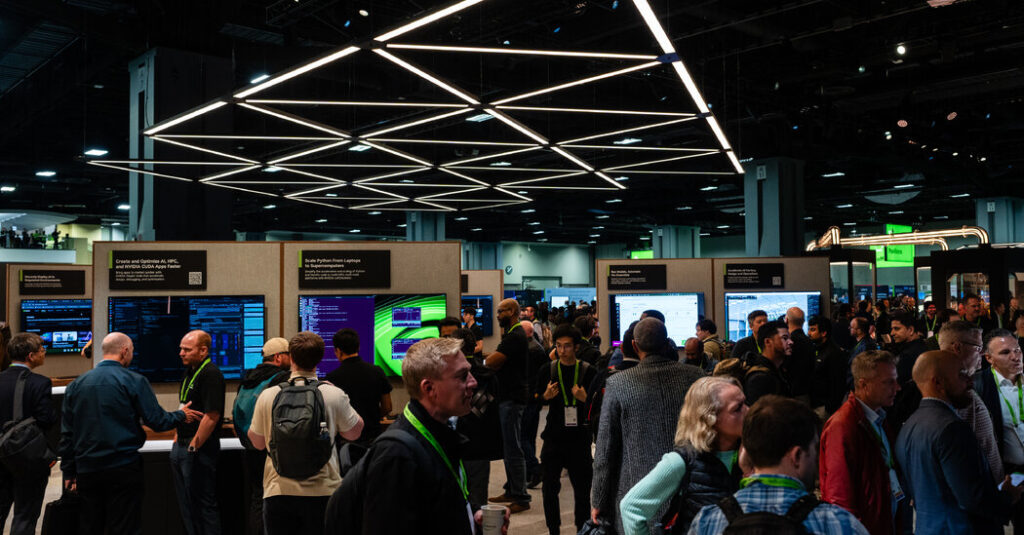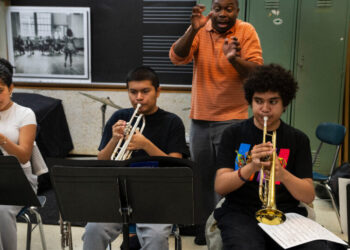The stock market bounces in recent weeks are just one indicator of the profound uncertainty and heightened risks running through the global economy and financial system.
It’s not simply that the hundreds of billions of dollars flooding into artificial intelligence investments might turn out to be a bubble. Or that the use of cryptocurrencies in mainstream banking is spreading even as their values have plunged after soaring to record highs. Or the billion dollar bankruptcies related to a mad rush of lending by shadow banks.
It is also the titanic levels of debt that the United States and other governments have built up. President Trump’s erratic policy zigzags. And the possibility that the cornerstone of the administration’s economic agenda — tariffs — could be ruled unconstitutional by the U.S. Supreme Court.
It’s everything, everywhere, all at once.
“I have just been flabbergasted that market measures of volatility have been so low up until recently,” said Kenneth Rogoff, a professor of economics at Harvard University. Market valuations are not accurately reflecting risks, he said.
The stock market run-up — the S&P 500 is still up about 14 percent this year despite the recent shivers — could foreshadow widespread economic gains. But Mr. Rogoff doesn’t think that is the case.
“A big part of the high stock prices is not a reflection of high future growth,” he said. Rather, it is a sign that A.I. is expected to boost productivity and shrink employment. “The firms all think they’re going to shed a lot of labor, and that’s why the profits will be high,” he said.
And while the construction of data centers to power artificial intelligence is fueling economic growth now, these centers, once built, employ skeleton staffs.
The uncertainty caused by the market speculation over A.I. is to a large extent unavoidable. How do you assess the impact and dollar value of a potentially life-changing invention?
In another century, the railroads transfigured the economy and set the stage for spectacular growth. But along the way there were lots of casualties. “Downton Abbey” fans will recall that Lord Grantham lost the family fortune investing in a failed Canadian railroad scheme.
“Every forecast was certain,” Downton’s paterfamilias protests after being told he is broke. “Rail shares were bound to make a fortune.” And many did, but not his.
The swoon-level stock market valuations of companies like Nvidia at $5 trillion seem to be predicated on the assumption that rapid growth will go on and on. Some of the players spending billions of dollars have yet to turn a profit.
Critics warn that a small group of tech companies, including Nvidia, are essentially buying and selling to each other in circular deals that inflate their actual value.
Across the corporate world, lofty stock prices are also being supported through loans from financial firms known as shadow banks that are not subject to the restrictions that curtail risky lending. And because the dealings of these private credit firms are veiled, it is difficult to assess how much risk there is in the system.
In many cases, established guard rails — like restrictions on what 401(k) retirement plans could invest in — are being rolled back by the Trump administration. As a result, long-term savings accounts for many Americans can now include investments in real estate, cryptocurrencies and private equity funds.
Such mingling of assets chips away firewalls that were designed to prevent risky financial gambles from infecting the broader financial system. Some experts see a dangerous build up of factors reminiscent of the risky practices that led to the financial crisis of 2008.
“That is pretty concerning,” said Natasha Sarin, a professor of law and finance at Yale University. “Even very sophisticated financial players do not really understand the risks.”
In Britain, Andrew Bailey, the governor of the Bank of England, warned last month of risky lending by private credit firms. He compared the current repackaging of financial products to what happened before the 2008 collapse.
“We certainly are beginning to see, for instance, what used to be called slicing and dicing and tranching of loan structures going on,” he said in testimony to Parliament, “and if you were involved before the financial crisis, then alarm bells start going off at that point.”
The International Monetary Fund similarly warned in October of “the new challenges to stability.”
Along the way, the mainstream bankers who had warned of the dangers from crypto and private lending have done an about-face and embraced them.
Two years ago, Jamie Dimon, the chief executive of JP Morgan Chase, called for cryptocurrencies to be banned. This month, the bank issued its own digital token.
In October, Mr. Dimon warned of the risks related to private credit after a string of bankruptcies, saying, “When you see one cockroach, there are probably more.”
Yet last week, the bank’s asset management arm told investors that private credit firms were an essential element in portfolios.
Even those who are certain that a crash may come sometime in the future don’t want to miss out on the boom before the fall.
“I think many of the big investment banks are trying to have it both ways,” said Eswar S. Prasad, author of “The Future of Money: How the Digital Revolution Is Transforming Currencies and Finance.” “It’s very difficult in a competitive environment to back off certain asset classes,” he said.
Government debts in the United States and other big economies are another source of worry. Vulnerabilities in the financial system are troubling, said Mr. Prasad, an economics professor at Cornell University. But he added, “I think the bigger concern, which is sort of festering in the background, is really the public debt situation, especially in the advanced economies.”
The U.S. government debt has reached $38 trillion, or roughly 125 percent of the size of the American economy.
The traditional bedrock faith in America’s credit worthiness was already rattled in April after Mr. Trump engineered a series of trade wars.
A new working paper from two leading economists, Alan J. Auerbach and William Gale, noted that there is widespread consensus that the United State’s debt burden and spending is “unsustainable.”
The “outlook, combined with frequent and unpredictable shifts in economic policy, could threaten the country’s global economic leadership, the reserve-currency status of the dollar and the safe-haven status of Treasury debt,” the two economists wrote. “The current debt situation is unlike any other episode the country has faced in the past.”
Of course, forecasting the future is a fool’s game. As the economist Paul Samuelson once joked, “the stock market has predicted nine out of the last five recessions.”
Still the accumulation of risk is disturbing. “It’s just so hard to know where this whole thing lands,” Mr. Rogoff at Harvard said. “I don’t have a good feeling about the general direction of things.”
Patricia Cohen writes about global economics for The Times and is based in London.
The post Market Volatility Underscores Epic Buildup of Global Risk appeared first on New York Times.




